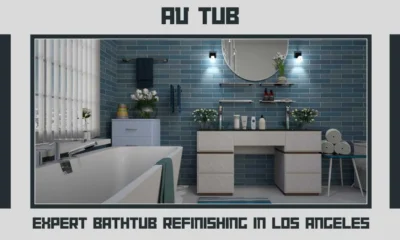HOME IMPROVEMENT
Understanding the Process: How Window Replacement Services Work

Window replacement is a transformative process that enhances a home’s aesthetic appeal and improves energy efficiency, security, and comfort. However, the process can feel overwhelming if you need to familiarize yourself with the steps involved. Homeowners often have questions about what to expect, how the project will unfold, and its impact on their daily routines. To address these uncertainties, we will explore the typical window replacement process, shedding light on each phase—from initial consultation to the final installation. Understanding these steps can help you prepare and make informed decisions, ensuring a successful project.
Consultation and Planning
The window replacement journey typically begins with a consultation at Maverick Windows serving all of Houston, where a representative visits your home to assess your needs and discuss options. This consultation is essential for understanding the project’s scope and your home’s unique characteristics. During the meeting, the representative may inspect the current windows to evaluate structural issues, measure window openings, and note potential challenges. They’ll also discuss your preferences, covering window styles, materials, energy efficiency features, and budget constraints. The aim is to match your needs with a suitable solution that aligns with your aesthetic vision and functional requirements.
The consultation phase is also an opportunity to ask questions and clarify doubts about the process. For instance, discuss the different window frames available, such as vinyl, wood, or fiberglass, as each material has unique advantages. Additionally, the representative might provide insights into energy-saving features like double glazing, low-E coatings, or gas fills, which can reduce heating and cooling costs. After gathering this information, the company will typically prepare a customized proposal outlining the recommended options and costs, ensuring transparency.
Product Selection and Customization
Once you’ve reviewed the proposal and agreed on the general outline of the project, it’s time to choose the specific products for your replacement windows. This step involves more than simply selecting a window style; it includes customization of features, materials, and finishes. Different window types—like casement, double-hung, or picture windows—offer varying ventilation levels, light control, and accessibility. Based on the insights shared during the consultation, the company may present options that align with your preferences, ensuring that each selection meets aesthetic and practical requirements.
Customizing windows allows you to create a product that fits seamlessly with the overall design of your home. For instance, choosing a particular frame color can help blend the new windows with your home’s exterior, while interior finishes can match your indoor decor. Beyond appearance, you may also decide on hardware, glazing options, and grid patterns, all of which contribute to the final look and functionality of the window. In this stage, many decisions come together to create a window tailored to your needs. The final selections are then sent for manufacturing, and the company typically provides an estimated timeline for when the windows will be ready for installation.
Preparing for Installation
Preparation becomes the next crucial step with the manufacturing complete and windows ready for installation. Both the company and the homeowner have roles in preparing for the installation day to ensure a smooth process. The company usually assigns a project manager or lead installer who will coordinate the team, oversee the logistics, and address any questions or concerns that might arise on the installation day. This individual will inform you about what to expect, how long the installation might take, and any steps you need to take to facilitate the process.
From the homeowner’s side, preparation involves clearing the area around the replaced windows. Removing curtains, blinds, and other window treatments allows installers easy access. Moving furniture or valuables from the vicinity can also prevent accidents and create a safer workspace for the crew. The team may use drop cloths to protect your floors and furniture from dust and debris, but clearing the area can speed up the process and ensure nothing gets damaged. By preparing your space in advance, you can contribute to a more efficient installation, minimizing disruptions to your daily routine.
Removing the Old Windows
Once the installers arrive and the area is prepped, the work begins with removing the existing windows. This part of the process requires precision, as the crew must carefully extract each window without damaging the surrounding structure or compromising the integrity of the opening. Depending on the condition of the old windows, this task can range from straightforward to challenging. Older windows, for example, may have deteriorated frames or worn-out seals that require extra care during removal to avoid structural damage.
After removing the old windows, the installers inspect the openings for signs of decay, rot, or moisture damage. If any issues are detected, they might need to repair or reinforce the area before proceeding. Ensuring the opening is clean, level, and structurally sound is essential for achieving a proper fit and seal with the new window. This step underscores the importance of hiring a knowledgeable team that can handle unexpected challenges with skill. Once the area is ready, the team will prepare the opening to receive the new window, often adding insulation or other materials to improve energy efficiency and provide a secure fit.
The window replacement process involves several well-coordinated steps, each crucial for achieving a successful result. From the initial consultation to the final inspection, each phase addresses specific needs and ensures a high-quality installation. By understanding these stages, homeowners can make informed decisions and better prepare for the project, contributing to a smoother experience. With your new windows in place, you can enjoy improved energy efficiency, enhanced comfort, and an updated appearance for your home.
-

 BIOGRAPHY7 months ago
BIOGRAPHY7 months agoBehind the Scenes with Sandra Orlow: An Exclusive Interview
-

 HOME1 year ago
HOME1 year agoDiscovering Insights: A Deep Dive into the //vital-mag.net blog
-

 HOME1 year ago
HOME1 year agoSifangds in Action: Real-Life Applications and Success Stories
-

 BIOGRAPHY1 year ago
BIOGRAPHY1 year agoThe Woman Behind the Comedian: Meet Andrew Santino Wife




























